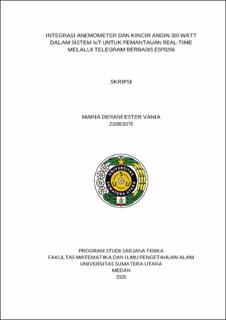Integrasi Anemometer dan Kincir Angin 300 Watt dalam Sistem IOT untuk Pemantauan Real-Time Melalui Telegram Berbasis Esp8266
Integration of an Anemometer and A 300-Watt Wind Turbine in an IOT System for Real-Time Monitoring Via Telegram Based on Esp8266

Date
2025-09-19Author
Vania, Maria Derani Ester
Advisor(s)
Brahmana, Kurnia
Metadata
Show full item recordAbstract
Optimizing the potential and realizing the utilization of wind energy, such as in the coastal areas of Lake Toba, particularly in Silalahi III Village, requires further adjustments to the use of turbine models, monitoring, and control systems to ensure efficiency and power stability against wind fluctuations. This research aims to design and experimentally test the integration of an anemometer with a 300-watt wind turbine integrated with IoT via Telegram for real-time monitoring of wind speed and electrical output power based on ESP8266. This prototype is equipped with a DC to DC converter to rectify the voltage and electrical power from the turbine. The testing was conducted at the foothills of Siantar Atas, Silalahi III Village, with a data acquisition interval of 10 minutes for 24 hours. The research results show that the average wind speed in the Silalahi III area is 5.27 m/s. The output current and average output power were 1.15 A and 14.70 Watts, with an output power conversion efficiency of 21.20%. The DC-to-DC converter rectifier system was able to produce a stable voltage value in the range of 12.1-13.3 V, thus consistently supplying sufficient electricity to operate a 10 W lamp load. The study found an inverse and non-linear relationship between wind speed and power efficiency, and a positive but scattered trend between output power and power efficiency (moderately positive), which deviates from the theoretical cut-in speed of the output power curve. This is attributed to external factors such as turbulence, wind direction, wind speed fluctuations, etc.
Collections
- Undergraduate Theses [1379]
